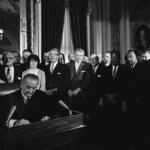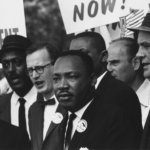While the Reconstruction Amendments were an important step in ensuring equal rights for all people, regardless of race, racial injustices throughout the United States continued into the late 19th and 20th centuries, leading to the Civil Rights movement of the 1960s, and the passages of Supreme Court decisions and legislation, including Brown v. Board of Education, the Civil Rights Act of 1964, and the Voting Rights Act of 1965. Visit the National Constitution Center’s learning module to learn more about the freedom struggle and civil rights.
Voting Rights in America Timeline
Supplement your students’ understanding of voting rights in the United States with this free downloadable timeline. This visual guide breaks down the history of voting rights across identities, and gives context to efforts to expand and limit voting access over time, through the lenses of our three branches of government and our federal system.
Competing Voices of the Civil Rights Movement
When most people think of the Civil Rights Movement in America, they think of Martin Luther King, Jr. delivering his “I Have a Dream” speech on the steps of the Lincoln Memorial in 1963 and receiving the Nobel Peace Prize the following year. But “the Movement” achieved its greatest results — the 1964 Civil Rights Act and the 1965 Voting Rights Act — due to the competing strategies and agendas of diverse individuals. Even black Americans, the primary beneficiaries of this landmark legislation, did not agree on the tactics that should be used to secure the equal protection of their rights. This unit presents the views of several important black leaders who shaped the debate over how to achieve freedom and equality in a nation that had long denied a portion of the American citizenry the full protection of their rights.
Expansion of Voting Rights
This lesson provides students with a brief overview of the historical evolution and expansion of voting rights in the United States. Students will discuss examples of previous “voting qualifications” used by states in the past to deny minorities the right to vote. They will reflect on why the right to vote is important, and appreciate the outcomes of constitutional amendments, Supreme Court decisions, and the Voting Rights Act in the expansion of this right.
Voting Rights Act of 1965: Lesson Plans & Resources

On August 6, 1965, President Lyndon B. Johnson signed the Voting Rights Act into law. This landmark piece of legislation made discrimination based on race illegal. This law protected the right to vote for all citizens; forced states to obey the Constitution; and reinforced the 15th Amendment. The Share My Lesson team has curated a collection of free lesson plans, activities, and classroom materials that educators can use to teach students about the Voting Rights Act.
Rights in America
This DocsTeach page includes a variety of primary sources and teaching activities exploring the ways Americans, including African Americans and others, have fought for, attained, and protected their rights. Many documents at the National Archives illustrate how individuals and groups asserted their rights as Americans. Use this site to find teaching activities to explore the topics such as slavery, racism, citizenship, women’s independence, immigration, and more.
19th Amendment: Women’s Right to Vote
In this learning module, students will trace the roots of the women’s rights movement, from early reform efforts in the 1800s to the ultimate decision to pursue voting rights. This unit explores the constitutional arguments over women’s suffrage, the historical context of the fight for suffrage over 70 years, and the tactics suffragists used to persuade state legislatures and the national government to recognize voting rights for women.
Should the Voting Age Be Lowered to 16?
Using this resource, students will view short C-SPAN video clips exploring the background and different arguments surrounding the question over the current voting age. This deliberation has students learn about the history of lowering the voting age and explore the question: Should the voting age be lowered to 16?
Voting Rights
The right of a citizen to vote is not directly protected in the Constitution, and throughout our history that right has often been granted to some, but denied to others. However, through various amendments to the Constitution, the right to vote has become more and more inclusive. Uncover the battle for voting rights in the National Constitution Center’s learning module.
March on Washington: Lesson Plans & Resources

On August 28, 1963, approximately 250,000 people participated in the March on Washington for Jobs and Freedom, which is considered to be one of the largest peaceful political rallies for human rights in history. Among other events, the march participants gathered at the Lincoln Memorial to hear Martin Luther King Jr. deliver his iconic “I Have a Dream” speech. Many consider The Great March on Washington to be the event that encouraged the passage of the Civil Rights Act of 1964 and the Voting Rights Act of 1965. The Share My Lesson team has created this collection of free lessons and classroom materials to help middle and high school educators teach their students about this historic event.